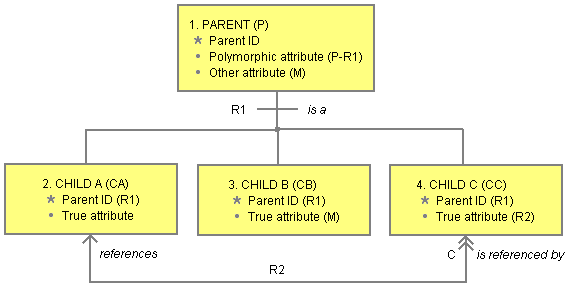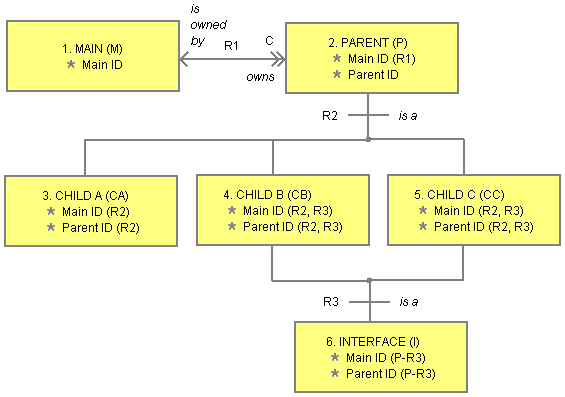

 Monday, 26 May 2008
Monday, 26 May 2008Polymorphic attributes are new to OOA10 and have only really become useful since OOA96 introduced mathematically dependent (i.e. derived) attributes. Previously, if a common non-identifying attribute was defined in most (not necessarily all) subtypes of a subtype-supertype relationship, it would be abstracted into the supertype object. This would only cause a problem if the attribute was referential in any of the subtype objects. In which case, the analyst would have to leave the referential attributes where they were and decide whether having a copy of the attribute in the supertype object was still beneficial. OOA96 introduced the concept of a constrained referential attribute and this could be used to constrain any referential attributes left in subtypes after a common attribute is abstracted into a supertype object. This situation does not happen often in my experience. However, with the introduction of mathematically dependent attributes, abstracting common attributes of mixed type becomes much more difficult. How do you abstract a common attribute which is a simple attribute in one subtype and a mathematically dependent attribute in another subtype? The answer is a polymorphic attribute.
Polymorphic attributes are similar to polymorphic events (which were also introduced in OOA96) in that polymorphic attributes in a supertype object are mapped to true attributes in subtype objects. An analyst associates a subtype-supertype relationship with a polymorphic attribute and then selects a subtype attribute in each of the relationship's subtype objects. Subtype attributes may themselves be polymorphic attributes. When we refer to true attributes we mean non-polymorphic attributes with any intermediate polymorphic attributes flattened out. Obviously, the object containing the polymorphic attribute must be the relationship's supertype object. It is rare for there to be more than one choice of subtype-supertype relationship, i.e. multiple supertype objects are rare.
Polymorphic attributes and their corresponding true attributes do not have to have the same name but they must have the same data type. However, OOA Tool can pre-select subtype attributes that have the same name and data type. This makes the creation of a polymorphic attribute a 2 second job in most cases. The conditionality of a polymorphic attribute is the weakest conditionality of any of it's true attributes, i.e. the polymorphic attribute is conditional (1c) if any true attribute is conditional. Furthermore, an analyst can make a polymorphic attribute conditional even if none of it's true attributes are conditional. One could argue that the data type of a polymorphic attribute should be the weakest data type of any of it's true attributes. However, to keep things simple, the data types of all true attributes must match in OOA10.

The example above shows a typical polymorphic attribute with a true attribute defined in each of the subtype objects. The attribute suffix of a polymorphic attribute begins with 'P' and includes the associated subtype-supertype relationship ID, e.g. (P-R1). Using the relationship ID is important since the associated relationship may be defined in another subsystem and thus may not be shown on a particular diagram. The attribute suffix (P) is used if there is no associated relationship at present. In the example above the true attributes are simple, mathematically dependent and referential.
Polymorphic Attribute above could be replaced by Other Attribute if the associated calculation code performed a simple switch on the supertype's current subtype returning the appropriate true attribute value. This would be unthinkable in an object-oriented programming language. However, in Shlaer-Mellor OOA, a subtype-supertype relationship is complete in the sense that all subtypes are identified by the analyst in the information model. Therefore, the switch code for Other Attribute would also be complete. OOA Tool will inform an analyst if a subtype switch statement is no longer complete, e.g. when a new subtype object is added. The disadvantage of using this approach is that the polymorphic relationship is hidden in Other Attribute's calculation code.

The diagram above shows how polymorphic attributes can be used to create interface like objects without having to create additional redundant relationships or use arbitrary IDs. Main ID and Parent ID in Interface would normally have to be referential attributes but that would require some form of relationship to Parent to resolve the referential attributes (OOA10 requires all referential attributes to resolve to a single base attribute). Alternatively, an arbitrary ID could be added to Interface and then used in Child B and Child C. Making these attributes polymorphic means that they can resolve downwards in R3 while the matching attributes in Child B and Child C reference upwards to formalize R3. This works because the matching attributes in Child B and Child C have an alternative path to their base attributes in Parent and Main. How referential attributes are resolved to base attributes and why they should all resolve to a single base attribute will be discussed another day.